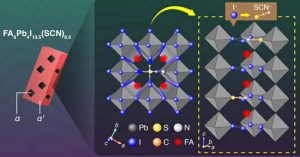Taming a promising, but flaky, solar perovskite


“Solar cells made of α-FAPbI3 exhibit a 25.8% conversion efficiency and an energy gap of 1.48eV, specifications that are highly desirable for real-life applications. Unfortunately, α-FAPbI3 is metastable at room temperature and undergoes a phase transition to δ-FAPbI3. The energy gap of δ-FAPbI3 is much larger than the ideal value for solar cell applications,” according to Tokyo Tech, which has worked out the mechanism behind one particular proposed stabilisation technique – swapping some of the iodine ions with thiocyanate ions (SCN-).
“Previous studies have shown that partial replacement of surface anions stabilises the α-phase. However, it is unclear how SCN- incorporate themselves within the perovskite lattice and increase the interfacial stability,” said Takafumi Yamamoto, who lead the research.
For the first time, according to Tokyo Tech, single crystal and powder samples of the thiocyanate-stabilised pseudo-cubic perovskite were prepared by the team, and detailed study revealed the relationship between the internal crystal structures and defects as the material moved between its phases.





